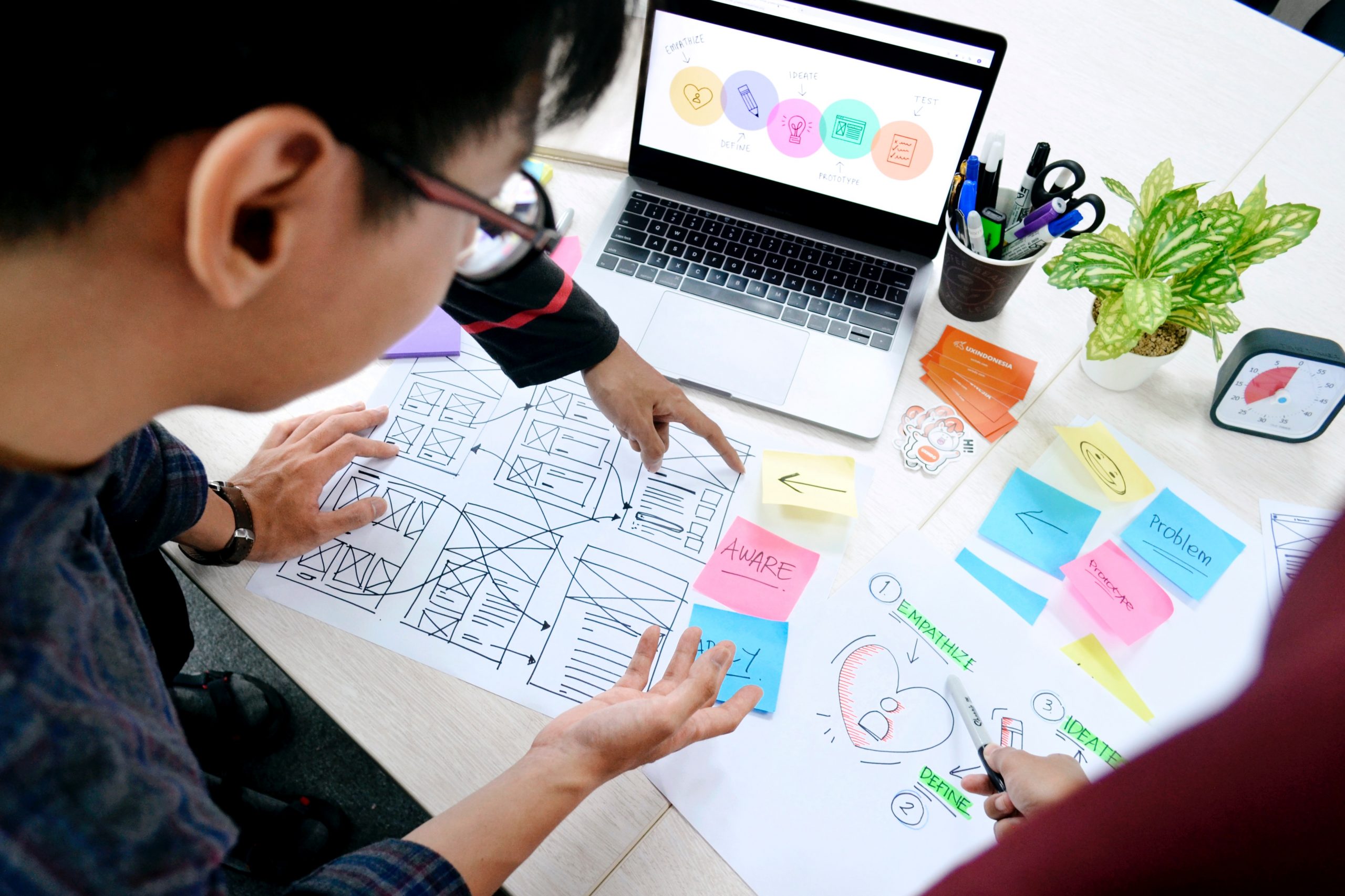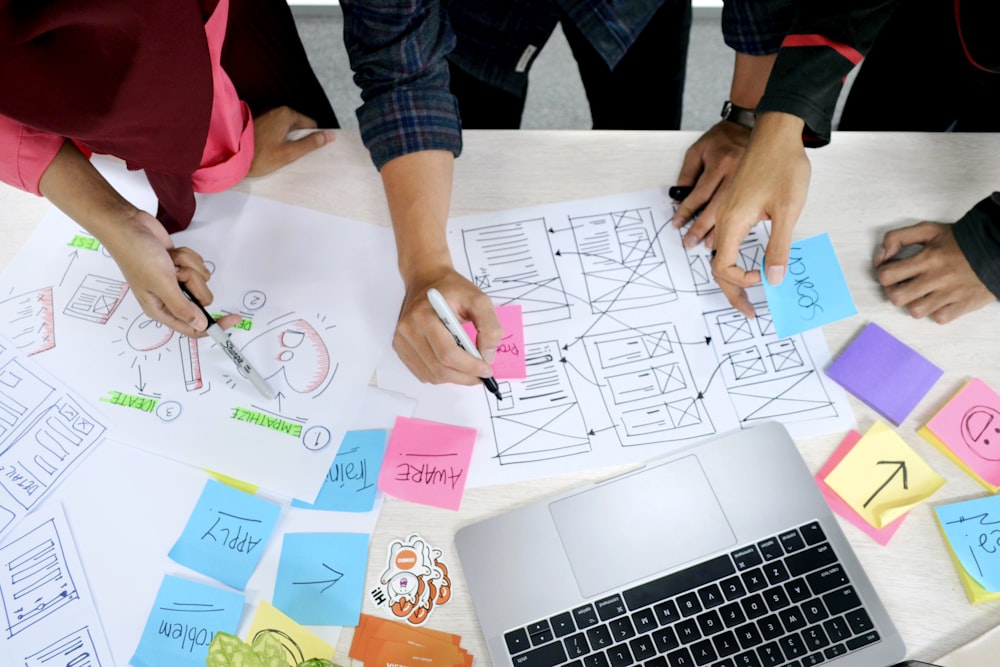
14 Apr InfoCentric Team Talks: What is Design Thinking in Analytics?
At InfoCentric we regularly practise knowledge-sharing between teams using our Team Talks lunchtime sessions. This month, we looked at the 5 step process for Design Thinking.
In this article, we’ll break down the key points to give you an insight into how our team uses Design Thinking.
What Is Design Thinking?
Design Thinking is essentially a process for solving a problem that’s all about observation. In Design Thinking, you use iterative processes that allow you to understand your users, challenge assumptions, redefine problems and create innovative solutions.
It’s a user-centric approach to focus on the people the products are for and identify gaps you want to solve, observing the culture and the people surrounding it. Design Thinking is an iterative and co-creative process that encourages trial and error to continuously improve the end results.
A Typical Design Thinking Process
There are 5 steps in a typical Design Thinking process:
- Empathy – to understand the needs and values of your audience.
- Discovery – to define our challenge and discover the problem to be solved.
- Ideation – brainstorm possible solutions and ideas to achieve them.
- Prototyping – where we build and test ideas.
- Execute – is how we get ready to launch.
Breaking Down The Design Thinking Process
Step One: EMPATHY
Empathy is the process of seeing the world through other people’s eyes and challenging assumptions. If you’re going to solve a problem, you need to gain a deep understanding of the realities of the people encountering that problem and understand how it impacts their life. So if you’re going to run a design thinking workshop with your team, it’s a good idea to bring along some research that your team can use for the first step of this process.
Ideally you’ve sourced this research by engaging with the people you’re designing for, who are actually experiencing the problem you’re trying to solve. That could mean visiting and observing their physical environment or surveying people and communities remotely through social channels for example, this way you can build data that you can streamline into personas.
By understanding our audience, the better we can target their needs and desires giving them what they really want, not what they think they want – this is when the audience is often referred to as a target market. This collection of people might share common traits like age, location, likes, dislikes, beliefs, behaviours or hobbies. Once we know who we are talking to, then we can really empathise with them.
Empathy is a lovely human quality, it’s where we relate to each other and care for each other’s needs. It’s the ability to acknowledge that others value different things or view the world in a different way. When we apply empathy to design, we ensure the final product serves the needs of others rather than ourselves.
Step Two: DISCOVERY
Moving on to the next step of the design process, is Discovery. We’ve worked out who we’re solving a problem for, so in this next step we want to define why. The Discovery phase is all about defining the problem that needs to be solved for your audience. Without a well-defined problem, it’s hard to know what your goal is, or how you know when you’ve solved it.
We all need a goal and when it comes to design thinking workshops, it’s essential that the team is united by tackling the same problem. One way to identify and frame a problem is to turn it into a statement. A problem statement is a concise sentence or maybe two, that identifies the gap between the current state and the desired state. It needs to focus on the user and be actionable. It works best when the team comes up with it together to figure out key problems, how we know they’re problems and how we know when it will be solved.
Step Three: IDEATION
Ideation is the process of brainstorming and putting down all the ideas your team can come up with to approach and solve the problem. In this stage nothing is off limits. The point isn’t to separate the good ideas from the bad, or even find the perfect solution, but just to come up with as many possibilities as you can.
We’re opening our minds and linking our research and sharing thoughts based on what we’ve learned so far. One of the main qualities of the ideate stage is that it’s collaborative, it involves everyone on the team. It’s thinking big about what could be, without any constraints.
Practical tip: Mind mapping is a great way of exhausting your ideas and then creating relationships between ideas. With mind mapping you’re able to trace your ideas back through pathways to create a new idea or add to an existing one. It works particularly well when working with a team, as anyone can jump in and keep evolving the idea or they can return to the source and see how the idea evolved.
Step Four: PROTOTYPING
After ideating with your team and generating plenty of ideas, it’s time to choose the best ideas and put them to the test. Prototyping is where you start to create working prototypes so that you can test them and then unearth any issues with your design.
A prototype might be a wall or virtual board of post-it notes, a storyboard, or a design mock-up as examples. The process of building a prototype will likely clarify the problem even more and offer new insights or new solutions that you hadn’t thought of before.
It’s helpful if prototypes can be experienced by your audience for the purpose of requesting feedback. In order to request feedback – you need to decide how to present the prototype so that it can be assessed against the problem it’s seeking to solve.
Step Five: EXECUTE
The execution stage is about bringing your idea to reality. It’s when clients may need to include external contractors or specialists like us to help get that final product made. This often involves funding – and like any grant application or funding request – it’s good to take people on the journey.
Presenting key elements from each step of the workshop provides a concise and clear journey, and facilitators should ensure they’ve collated all the elements from the previous steps.
How To Work With Design Thinking Principles
There’s no one way to do design thinking. It’s always recommended to make the process your own, combining the steps above, reducing them if necessary or adding more steps to improve the overall process.
It’s a tried and tested method that can help you design products and services that are perfectly tailored to your audience.
Learn More:




